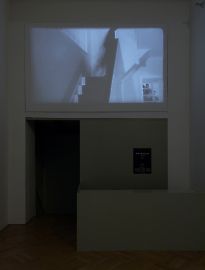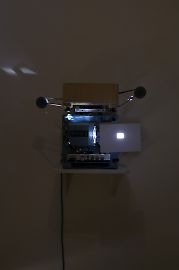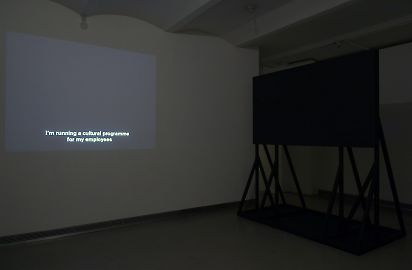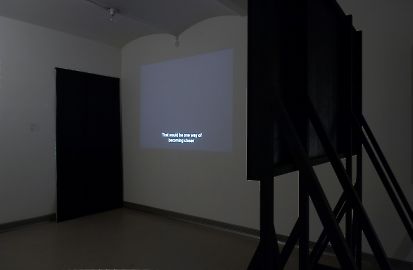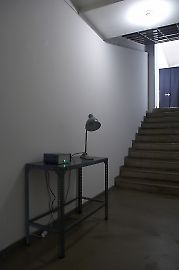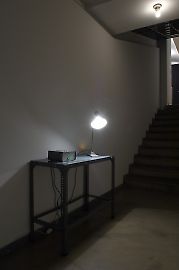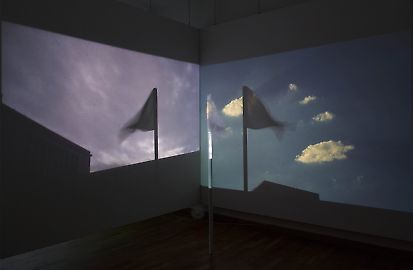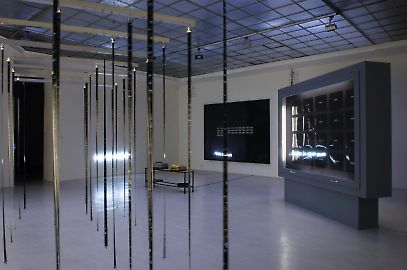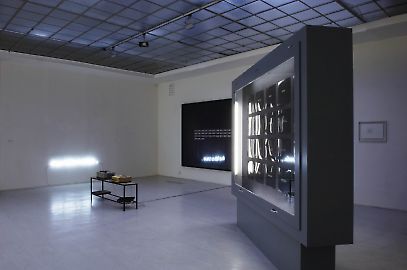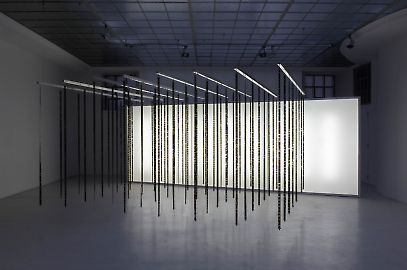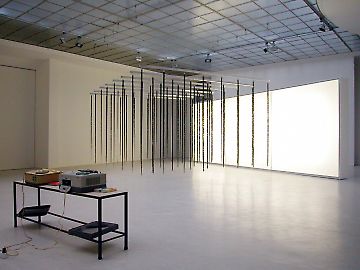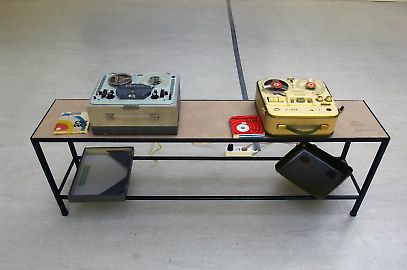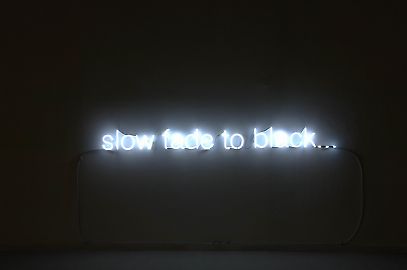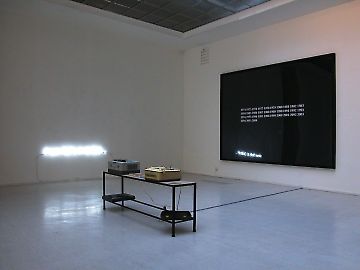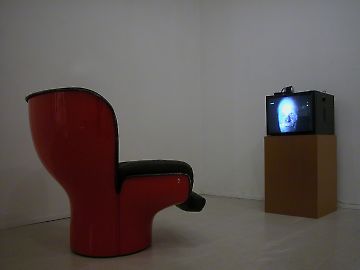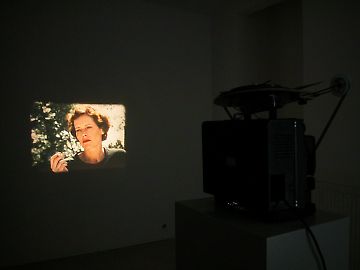[scene missing] --
Manon de Boer, Cerith Wyn Evans, Andreas Fogarasi, Björn Kämmerer, Theo Ligthart, Ján Mancuska, Christian Mayer, Wolfgang Plöger, Nadim Vardag, Marijke van Warmerdam, Christoph Weber
The exhibition [scene missing] groups eleven recent artistic positions that engage with cinema and film. Without showing film in the usual sense or simulating cinematic situations, the works presented here all interrogate methods of narrative construction and point out the fragmentary character of reality and its filmic representation. The absence of cinema and film at the exhibition [scene missing] is a product of our collective film memory. The receiver completes "the scene missing” by taking recourse to his or her own memories of cinema and film history. In the field of tension between the black box and the white cube, the cinema becomes a material in the works exhibited.
In contrast to avant-garde film and the expanded cinema, the motivation behind this artistic practice is not breaking with standard conventions, but rather the appropriation of such conventions. The conventions of filmic representation provide a starting point. Narrative structures, an interest in the mechanics of the projection apparatus, cinematographic traditions and the reception of film are all subjected to deconstruction and recoding. Film history becomes raw material.
Björn Kämmerer, Marijke van Warmerdam, Manon de Boer and Christoph Weber share a common interest. They make use of antiquated technology, forcing onto film projectors or old tape players functions for which they were not intended. The mechanical apparatus is staged as fetish.
In his 35mm film loop escalator (2006), the German artist Björn Kämmerer shows a boy dressed in coat and tie walking up and down a stairway, apparently endlessly. The linear narrative structure and spatial orientation is suspended by the editing and reflection and generates a disturbing sense of infinitude.
The 16mm film loop Passage (1992) by the Dutch artist Marijke van Warmerdam shows a black small square that slowly emerges from the middle of a white backdrop to fill the entire projection surface; after the process has completed, it then starts again. This perpetual motion engenders associations in the spectator that can allow stories to develop. As the artist puts it, “Passage is a work which troubles my eye and my thoughts. I have the feeling that the phenomenon film has been stripped to the bone, but still someone is pulling my leg. In the meantime, my eye is very much attracted by its movements in black and white. It could be a tunnel, it could be an elevator, it could be the beginning of a story. In fact, it is no more than what it is. Or isn't it?"
Nadim Vardag explores the construction of mediated images and questions the mechanisms of cinema and film production using quite diverse media: sculpture, drawing, and film. In the work The Night (2005) Vardag uses the subtitles from the Antonioni film of the same name. The absence of image and sound places the focus on the written dialogue. The screenplay seems to return as the starting point for making a film, serving as material for the viewer to imagine a film of his or her own: beholder becomes director. Similarly, Black Screen (2007) challenges us to fill the void black screen with our own individual projections. This sculptural work represents the mimetic depiction of a surface of projection: dysfunctional due to its being black, it remains empty and imageless. At the same time, the work also recalls minimalist sculpture and functions as a projection surface for our own cinema memories.
In this work Avant-Garde (Rainer, Kubelka, Ligthart) (2002) Theo Ligthart analyzes an icon of avant-garde film: Peter Kubelka's film Arnulf Rainer (1960). Rainer had commissioned Kubelka to produce a documentary on his artistic work; to Rainer’s surprise, Kubelka then presented him with a film consisting exclusively of white and black squares in a rhythmic sequence that was subject to a strict score. Ligthart translates this score in his work Avant-Garde (Rainer, Kubelka, Ligthart) to a rhythm of light and dark by synchronizing the supply of electricity supply for a light source according to the score of Kubelka’s film, using a small box with a processor to control the flow of electricity. This box can be attached to any random light source, allowing any living room to be transformed into an avant-garde cinema. His work Spielfilm (Director’s Cut) (2002-2004) shown in the gallery skylight hall is formally based on the visual language of avant-garde film. The break with filmic narration in experimental cinema is here taken to its absurd limit; plots from mainstream cinema are all combined into a single sentence and presented in a formal reproduction of a cinema advertising case, thus referring to the aesthetic of film stills as shown in such displays in Central Europe. The result is a sequence of text images that displays the redundancy of the standard narrative cinema in an ironic way and directly inspires the individual film memory of the receiver.
In end (2007) and 1974, 1975, 1976... (2007), Andreas Fogarasi presents monumental silk screens of the intertitles from his video installation Kultur und Freizeit (2006), which was on view at the last Venice Biennale. The size of the works corresponds to the projection surface of his video. The film deals with cultural and educational institutions in Budapest, their architecture and the change in programming and questions about the aesthetic and structural notions of their builders and users. The intertitles, which originally point to the former and current realities of architectures presented, are extracted from the videos. Now robbed of their context, they become projection surfaces for individual memories.
In his installation untitled (one, two flags) (2008), the German artist Wolfgang Plöger shows two slide projections of rooftop landscapes; between the two he has placed a flag being blown by a fan. The static projections are animated by the moving shadow of the flattering flag; the motionless image seems to become cinematic. Shadow theater fuses with realistic photography, forming a poetic installation. The link of the real, present object of the flag and the unreal roof landscape pose the question of the representation of reality by the cinematographic apparatus and the perception of reality linked to it.
The installation Sorry Being So Late (2007) by Czech artist Ján Mancuska is based on photographs taken in Prague’s largest park, just near the artist’s home. Over the map of the park, he placed a grid, and walked from sunrise to sunset from one of the sixty-four points on the grid to another, shooting photographs from each point of intersection. Thus, each roll of film hanging from the ceiling marks a grid point and the perspectives of the park that can be seen from there. The work documents the entire area of the park and its change in daylight. Presented in front of an oversized light box, the beholder can take up the spatial as well as temporal sequence of the park and the course of the day, but in a fully different space and time relationship. By choosing the points of intersection as a camera position, the entire landscape seems to be documented, but these very points of intersection become the blind spots in the park’s documentation. The hanging rolls of film stand for the lack of depictions of the sites from which the park was photographed.
In Christoph Weber’s work Telefunken und Tesla (2007) two tape recorders from the late 1950s (a West German Telefunken and a Czechoslovakian Tesla) — enter into an apparent dialogue with one another. The machines play back fragments of a text compiled of fragments from German versions of various science fiction films from the 1950s to today. They enter into a fictive dialogue that represents in an emotionally dramatic fashion the scientifically charged propaganda battles of the Cold War in a television spaceship. By contrasting two devices from the early days of home recording, the artist refers to a time when the propaganda battle between east and west was at its climax and found its way into household archives through such media.
Since the early 1990s, Welsh artist Cerith Wyn Evans has been combining multilayered references from literature, poetry, philosophy, film theory, and the modern natural sciences with formal allusions to the conceptual models of the art work from the 1960s and 1970s in his work. In expansive installations—light writing on walls, film projections, and sculptural objects—Wyn Evans thus evokes an aesthetic cosmos in which the unending process of subjective and associative perception takes the place of clarity and transparency in conveying information. The work exhibited here slow fade to black… (reversed) (2004) comes from the artist’s Subtitle Series. The spatial placement of the neon lighting close to the floor transforms the gallery’s white wall into a film-like image. But the content of the sentence contrasts with the garish neon light and bright walls; slow fade to black suggests the slow disappearance of the image, whereby this expectation is constantly disappointed.
For the Indian born artist Manon de Boer, history is not a linear series of events but the experience of a constant process in which selective memories are set in relation to one another in a very particular way. Using the personal story as a narrative method, Boer explores the relationship between language, time, and the claim to truth in her work. The “narrative history” of key figures from various contexts, like Sylvia Kristel, who achieved some fame as the actress Emanuelle, allows the artist to explore concepts of memory and conviction and the coincidence of lived and written history in general. Sylvia, March 1&2, 2001 Hollywood Hills (2001) shows a close up of Sylvia Kristel looking into the camera and smoking. The rattling sound of the 16mm projector becomes the sound track of the silent dialogue between the figure represented and the artist. The tradition of portraiture is thus linked to individual filmic memory.
Christian Mayer’s film Sherlock Jr. (Buster Keaton, 1924) will be shown as a film supporting the regular program at Top Kino in the framework of the exhibition [scene missing]—a supporting film that does entirely without images. In this film, a scene from the Buster Keaton film Sherlock Jr. is described in the fashion of the running commentary that is provided for the blind or vision-impaired. While the film projector only projects white light on the screen, a voice describes how Keaton springs through a cinema screen into a film, where as an active figure he tumbles into a whole series of calamities, for he refuses to understand the discontinuity of time and space in film. By replacing the original filmic image with an oral narrative, this sound film expands the complex architecture of Keaton’s film into the viewing space. The narrative places the story directly in our imagination and allows us to imagine a space where fiction and reality can no longer be distinguished from one another.
Text / Curator: Fiona Liewehr


